
Review Article
Austin J Nutri Food Sci. 2016; 4(2): 1080.
Application of Pulsed Electric Field Technology in Apple Juice Processing
Sameh A. Korma1,2*, Kamal-Alahmad1,3, Abdelmoneim H. Ali1,2, Muhammad Shoaib¹*, Sherif M. Abed¹, Harimana Yves¹, John Nsor- Atindana4 and Jie Qin¹
¹State Key Laboratory of Food Science and Technology, School of Food Science and Technology, Jiangnan University, China
²Department of Food Science, Faculty of Agriculture, Zagazig University, Egypt
3Department of Food Science and Technology, Faculty of Agriculture, University of Alfurat, Syria
4Department of Nutrition and Dietetics, University of Health and Allied Sciences, School of Allied Sciences, Ghana
*Corresponding author: Sameh A. Korma, State Key Laboratory of Food Science and Technology, School of Food Science and Technology, Jiangnan University, China and Department of Food Science, Faculty of Agriculture, Zagazig University, Egypt
Muhammad Shoaib, State Key Laboratory of Food Science and Technology, School of Food Science and Technology, Jiangnan University, China
Received: August 23, 2016; Accepted: September 30, 2016; Published: October 04, 2016
Abstract
Pulsed Electric Fields (PEF) technology possesses high potential in fruit juice processing as a novel method for pasteurization, extraction of juice and biochemical components and reduction of enzymatic activity. In comparison with conventional methods, products are less affected after PEF treatment and maintain higher quality throughout the storage period. This review provides insight knowledge about the overall effect of PEF technology on the quality of polyphenol-enriched cloudy apple juice. During cloudy apple juice processing, PEF was applied for juice extraction, polyphenol extraction from apple, pasteurization and finally health benefits for apple polyphenols.
Keywords: Pulsed electric fields; Cloudy apple juice; Polyphenol; Extraction; Pasteurization
Introduction
One of the most widely known groups of natural metabolites are plants’ derived phenolic compounds, which secondary metabolites of plants. Fundamentally, these secondary metabolites act to provide protection for the plants in the event of biological and environmental stresses, and so are usually produced in response to pathogenic confrontation or exposure to high-energy radiations. As chief sources of phenolic phytochemicals, the regular consumption of fruits and vegetables has long been recognized and many epidemiological investigations support a strong correlation between these chief sources intake and incidence of degenerative disorders including cardiovascular diseases and different forms of cancers [1]. It is believed that fruits and vegetables by virtue of their high content of antioxidants provide protective effect for critical biomolecules such as DNA, protein and lipids from oxidation due to the production of free radicals during both normal metabolism and stress conditions [2].
In addition to novel technologies for food processing, functional foods is one of the subjects undergoing investigation in research and industry. Research suggests that a diet high in fruits and vegetables decrease the risk of chronic diseases due to the key role played by phytochemicals such as phenols, flavonoids and carotenoids [3].
Apples (Malusdomestica) are a rich source of polyphenols and apple juice is widely consumed in the world [4]. Researchers concluded that cloudy apple juice, with more pulp particles, contains more polyphenols and therefore is healthier than clear apple juice [5]. Boyer and Liu [3]; van der Sluis, Dekker [6]. Found the Cloudy apple juice had double the amount of polyphenolic compounds as flavonol glycosides (flavonoids, quercetin and quercetin conjugates), catechins and epicatechins, anthocyanins, dihydrochalcones (phlorotin and phlorizin), phenolic acids (gallic acid and chlorogenic acid) and procyanidinsand was much more effective at attacking and binding free radicals than clear apple juice. Also fruit juices make an important contribution to phenolic intake. Consumer opinion is firmly in favor of antioxidant consumption and juice manufacturers are exploiting this in their marketing campaigns. In addition, there is a strong consumer demand for safe, nutritious foods which are minimally processed.
As well as influences of processing on the survival and profiles of nutraceuticals are of high concern from both consumers and food scientists. Further enhancement of polyphenolic and organoleptic qualities of cloudy apple juice may be possible through application of PEF technology for the optimization of juice and polyphenol extraction, as well as mild pasteurization with keep on their original sensorial and nutritional characteristics after processing [7].
Pulsed Electric Field Technology
PEF treatment is classified as a non-thermal food processing method because the very low rise in temperature during application. By design, the test system composed of treatment chamber with a pump to conduct food through it, a cooling device, high-voltage power supply, energy storage capacity, and computer for operating the system controls.A continuous flow diagram for PEF processing is illustrated in Figure 1.
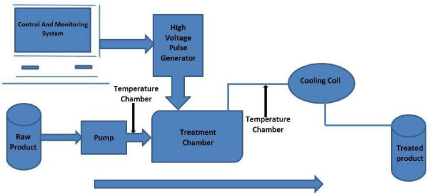
Figure 1: Schematics of a PEF processing system for pumpable products [8].
The technology of PEF is based on the principles of the changes or rapture of cells subjected to adequately enormous outside electric field, which causes increase permeability and electrical conductivity of the cellular matter [9]. The cell membranes develop permanent or temporary pores, based on the intensity and treatments under high electric filed pulses (Figure 2). The presence of the pores improves membrane permeability, leading to the loss of content of cell or intrusion of external immediate media. In situations where low intensity treatment is employed, stress reactions can potentially induce the upgrade of defense mechanisms by elevating the synthesis of secondary metabolites. The barrier effect of the cell membrane can be destroyed by permanent perforation and causes the lethality of the cell [10]. In this regard, PEF could be applied for tissue softening, enhancement of extraction processes andpasteurization [11]. In comparative to the use of heat treatments for pasteurization, PEF cannot causeprotein coagulation or gelatinization of starch. Moreover, covalent chemical bonds are unaffected hence the nutrients remain intact.
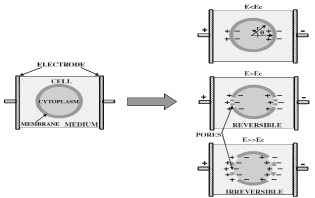
Figure 2: Biological cell in an electric field, E. Electroporated area is
represented with a dashed line. Ec: critical electric field strength [10].
Pulsed Electric Field Assisted Apple Juice Extraction
During processing of raw foods, cells that enclose valuable compounds are damaged to facilitate intracellular recovery. To enhance the efficiency of the widely used hydraulic pressing in food industry for improving yield in the production of fruits juice and oils, plasmolysis, cellular destruction or permeability of food cells are activated by pretreatments [12]. Conventional pretreatments commonly used to achieve plasmolysis include heating, osmotic dehydration or freezing, dehydration, alkaline breakage and enzymatic treatment. The techniques are characterized by the use of high mechanical or thermal energy, long holding times and large storage tanks for enzymatic treatment [13].
In addition to cost associated with the high-energy usage, nutritionally and physiologically molecules could be significantly lost due to the adverse consequence of the activities of endogenous and added enzymes as well as thermal degradation. To overcome these challenges, a PEF treatment could be applied. In contrast to the conventional pretreatments, PEF can be performed at room temperature in a continuous fashion in a short period of time within the seconds range. Figure 3 shows a flow chart illustrating such a process.
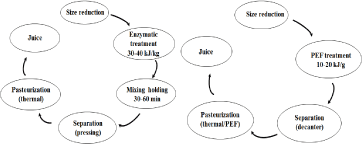
Figure 3: Fruit juice processing with conventional and PEF pretreatment prior
to liquid-solid separation [13].
An energy input of 10–20 kJ/kg is usually required in PEF treatment. For assumption of heat energy recovery rate of 75%, an energy input of 30–40 kJ/kg will be needed for pretreating to raise temperature from15 to 55°C prior to maceration. Effective permeability of cellular membrane could be achieved by a moderate pulsed electric filed intensity. Bazhal and Vorobiev [14] demonstrated that pressing of PEF treated apple at a pressure of 3-MPa and 0,2 -0,3 MPa led to an increased juice yield of 12% and 40% respectively, against untreated samples. This data suggest that PEF treatment offers additional benefits of lower energy requirement [15].
It is investigated that the treatment of both whole and sliced apple tissues by PEF was accompanied by an increase in juice yield (Figure 4). Efficiency of the PEF treatment increased with the electric field strength and kinetics of juice extraction was accelerated. However, juice yield was higher for apple slices in comparison with whole samples.
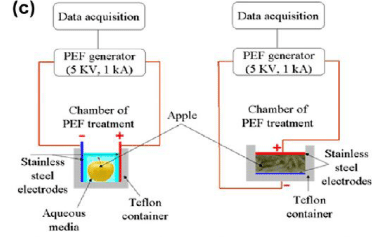
Figure 4: Experimental setup for PEF treatment of whole and sliced apples
[15].
Application of pulsed electric field for the recovery of polyphenols from by-products
Generation of large volumes of solid wastes including peels, seeds, stones, and oilseed meals associated with fruits processing. Value addition through the exploitation to produce nutritional value added additives from these industrial waste matters have received a great deal of attention. Figure 5 shows a general flow diagram for the recovery of various dietary components from fruit pomace.
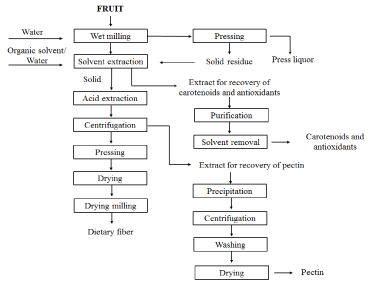
Figure 5: Utilisation of fruit pomace [16].
Preservation of apple juice by pulsed electric field
Pasteurization of fruit juices is performed by conventional thermal processes namely low temperature-long time (LTLT), high temperature-short time (HTST) and ultra-high treatment (UHT). HTST is normally carried out in a plate heat exchanger with stages of preheating, heating, holding and cooling in a single passage. UHT processing involves the production of a sterile product by rapid heating to high temperatures followed by a short holding time and ending with rapid cooling. HTST pasteurization is, possibly, the most widely employed technique for heat treatment of apple juices. Commercially, apple juice is processed at 77-88°C for 25-30seconds by HTST [17]. Though thermal pasteurization is well known for its effectiveness in preventing microbial spoilage of fruits juices, it isbiochemically and nutritionally unattractive due its possible influence which may impact negatively on the final product quality.
According to the FDA, fruit juice processors should attain a 5 logarithmical cycle reduction in the most resistant organism counts by the applied techniques. The microbial count should be less than 100 Colony Forming Units (CFU) [18]. Manyresearch on the application of PEF pasteurize apple juice has been carried out. PEF was compared directly with HTST. zárate-Rodríguez, Ortega-Rivas [19], found that PEF was efficient in microbial inactivation, as well as in preserving some apple juice quality attributes such as pH and color. HTST however, had apparent effects on pH and browning increase. The preservation of color was supported by Aguilar-Rosas, Ballinas- Casarrubias [20]. When they analyzed the direct effects of PEF, in comparison with HTST, on the concentration of eight volatiles found in apple juice. Generally, PEF retained most of the volatile compounds responsible for color and flavor of the apple juice, as (Acetic acid,Hexanal, Butyl hexanoate, Ethyl acetate, Ethyl butyrate, Methyl butyrate, Hexyl acetate). In addition, more polyphenols were retained by PEF than HTST according to [20].
Aguilar-Rosas, Ballinas-Casarrubias [20], found that the amount of total phenol compounds (Gallic acid) of apple juice for PEF treated samples more than HTST treated samples when compared between HTST and PEF pasteurization techniques.
With respect to shelf life, Torkamani [18], found that thermal Pasteurization of apple juice is significantly more efficient in bacterial decrease than PEF. Nevertheless, PEF treated samples constantly had a log count less than HTST treated samples. This is acceptable according to marketing standards. The apple juice also had better flavor and color.
Comparative studies of PEF and other non-thermal techniques have also been reported. PEF and ultrafiltration (UF) were utilized for Pasteurization of apple juice [19]. No significant changes were observed in variables such as pH, sugar content and acidity, expressed as malic acid; for both treatments. Color is the quality attribute that showed change. The juice became darker as a function of applied trans-membrane pressure and paler as a function of applied field strength. The observed browning in the UF process is considered a quality problem. However, there is evidence that it can be controlled by membrane pore size effects. Taking into consideration that PEF inactivates microorganisms based on their electromechanical instability, lethality varies not only for different species but also different growth phases [21].
Apple juice processing
Globally, apples are well known raw commodities for the manufacture of clear and cloudy juices as well as clear concentrates. The chief producers of apple juices are found mainly in USA, China, Poland, Germany, Argentina, Italy and Chile [22]. There are hundreds of apple cultivars, but only about 20 are commercially important. While several cultivars are grown exclusively for use in processing, some of the harvest of all commercial cultivars is used in processed products. Only sound, ripe fruit is used for further processing because decay, damage, maturity, firmness, color, soluble solids, acids and tannins impact the quality of the product. There are a number of procedures employed in apple juice production depending on the end product desired. Figure 6 shows descriptive sketches of steps for producing cloudy, clear and concentrated apple juice. The selected apples are crushed to a pulp before pressing. To increase the yield of juice extracted, it is vital to break down the cell wall of the fruits by pulping prior to the addition of enzymes. In the pressing phase, the juice moves from the pulp via the press cloth sleeves, along grooves in the malleable rods and out to the collecting channels at the end of the cage.
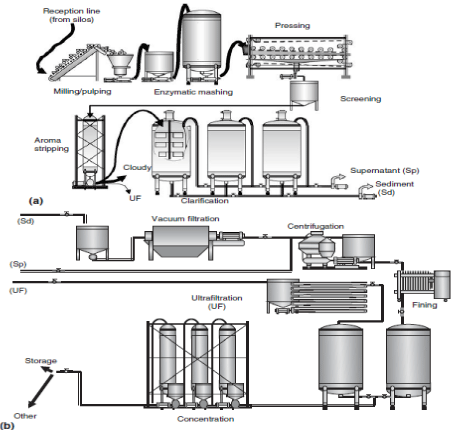
Figure 6: Typical apple juice processing plant. (a) From fruit to cloudy juice,
(b) From cloudy juice to clear concentrate.
Health benefits of apple polyphenols
In contrast with whole fruits, clear apple juice is associated with low phenolic level due to the clarification processes, which often causes drastic damages to phenolic profile. As an important soluble dietary fibre, pectin is key ingredient known for its role in the prevention of obesity, arteriosclerosis and diabetes [23]. However, clarified apple juice lacks significant amount of this soluble dietary fiber relative to the raw material. In this regard, un-clarified apple juice, which reportedly contained 2.8 times higher than that of clarified ones have been introduced and sold as cloudy apple juice the market. Additionally, the cloudy juice provides more (2.5 times) antioxidant activity compared to the clarified juices [5]. Apart from polyphenolic compounds, Vitamin C is also a chief contributor of apples’ antioxidant activities. Flavonol glycosides, catechins and epicatechins, anthocyanins, dihydrochalcones, phenolic acids and procyanidins are the major classes of polyphenols in apples. All these compounds are found in the apple flesh and seeds, with the exception of quercetin conjugates, which are located in the peels [24].
Apple polyphenols, particularly phloridzin, functions to hinderthe uptake of glucose from the intestinal tract by impeding certain specific glucose transporters in the intestinal lining [25]. Additionally, it functions to block the development of superior glycation end products, thereby protecting cells from damage and inflammation [26]. Recently, it was reported that apple polyphenols might protect animals with the deadly H1N1 influenza virus, a potential cause of death among elderly people. In this report, it observed that flu infected stressed animals died faster than the control, while those tested with apple polyphenols survived at higher rates [27].Many students are currently ongoing to further assess the capacity of apple phenolic compounds to overcome changes that lead to cardiovascular diseases, cancers, diabetes and other chronic infections.
The acceptance of apple juice as a popular beverage cannot be doubted on a global scale; due to the wide perception the commodity is a nutritionally wholesome product. To assess the overall quality of apple juice, it is vital to recognize some organoleptic parameters including color, aroma and flavor as well as the nutritional properties since final consumer associate freshness and authenticity with these parameters. In view of the backdrop that antioxidant activity of apple juice is chiefly associated with the amount of phenolic compounds and Vitamin C retained after processing, it is imperative for researchers come out with innovative techniques to combat the challenges associate the losses during processing of apple juice.
Conclusion
Pulsed Electric Fields (PEF) is a mild technology compared to thermal pasteurization because a lower temperature to kills microorganisms is used during processing, leading to a better retention of the quality (original color, flavor, texture, and nutritional value) with enhancing the juice extraction and providing the products for consumers with microbiologically-safe and freshlike quality foods. In addition to PEF technology in combination with standard operations of the food industry, such as mechanical pressing and extraction with solvent, used to improve the efficiency of these processes and to add value to food products and by-products. Furthermore, it can be a useful tool for food processing without any quality defects and nutritional losses.
References
- Tiwari BK, O’Donnell CP, Cullen PJ. Effect of non thermal processing technologies on the anthocyanin content of fruit juices. Trends in Food Science & Technology. 2009; 20: 137-145.
- Hancock RD, Stewart D. 25 Enhancing the Nutritional Quality of Fruit Juices. Biotechnology in functional foods and nutraceuticals. 2010; 465.
- Boyer J, Liu RH. Apple phytochemicals and their health benefits. Nutrition journal. 2004. 3: 1.
- Doris Jaros, Ines Thamke, Heike Raddatz, Harald Rohm. Single-cultivar cloudy juice made from table apples: an attempt to identify the driving force for sensory preference. European Food Research and Technology. 2009; 229: 51-61.
- Candrawinata VI, Blades BL, Golding JB, Stathopoulos CE, Roach PD. Effect of clarification on the polyphenolic compound content and antioxidant activity of commercial apple juices. International Food Research Journal. 2012; 19: 1055-1061.
- van der Sluis AA, Dekker M, van Boekel MA. Activity and concentration of polyphenolic antioxidants in apple juice. 3. Stability during storage. Journal of agricultural and food chemistry. 2005; 53: 1073-1080.
- Toepfl S, Heinz V, Knorr D, High intensity pulsed electric fields applied for food preservation. Chemical Engineering and Processing: Process Intensification. 2007; 46: 537-546.
- Maged EA Mohamed, Ayman H. Amer Eissa. Pulsed Electric Fields for Food Processing Technology. 2012.
- Martín-Belloso O, Marsellés-Fontanet AR, Elez-Martínez P. Food Safety Aspects of Pulsed Electric Fields. 2014: 169-178.
- Nickoloff JA. Plant cell electroporation and electrofusion protocols. Springer Science & Business Media.1995; 55.
- Praporscic I, Mykola Shynkaryk, Nikolai I Lebovka, Eugene Vorobiev. Analysis of juice colour and dry matter content during pulsed electric field enhanced expression of soft plant tissues. Journal of food engineering, 2007. 79: 662-670.
- Donsì F, Ferrari G, Pataro G. Applications of pulsed electric field treatments for the enhancement of mass transfer from vegetable tissue. Food Engineering Reviews, 2010. 2: 109-130.
- Toepfl S, Mathys A, Heinz V, Knorr D. Review: Potential of High Hydrostatic Pressure and Pulsed Electric Fields for Energy Efficient and Environmentally Friendly Food Processing. Food Reviews International. 2006; 22: 405-423.
- Bazhal M, Vorobiev E. Electrical treatment of apple cossettes for intensifying juice pressing. Journal of the Science of Food and Agriculture. 2000; 80: 1668-1674.
- Nabil Grimi, Fatine Mamouni, Nikolai I Lebovka, Jean Vaxelaire. Impact of apple processing modes on extracted juice quality: Pressing assisted by pulsed electric fields. Journal of Food Engineering. 2011; 103: 52-61.
- Djilas S, Canadanovic-Brunet J, Cetkovic G. By-products of fruits processing as a source of phytochemicals. Chemical Industry and Chemical Engineering Quarterly. 2009; 15: 191-202.
- Turk MF, Vorobiev E, Baron A. Improving apple juice expression and quality by pulsed electric field on an industrial scale. LWT - Food Science and Technology, 2012; 49: 245-250.
- Torkamani A. Impact of PEF and thermal processing on apple juice shelf life. Iranian journal of microbiology, 2011; 3: 152.
- Zárate-Rodríguez E, Ortega-Rivas E, Barbosa-Cánovas G. Quality changes in apple juice as related to nonthermal processing. Journal of Food Quality, 2000; 23: 337-349.
- Aguilar-Rosasa SF, Ballinas-Casarrubiasa ML, Nevarez-Moorillona GV, Martin-Bellosob O, Ortega-Rivasa E. Thermal and pulsed electric fields pasteurization of apple juice: Effects on physicochemical properties and flavour compounds. Journal of Food Engineering. 2007; 83: 41-46.
- Ortega-Rivas E. Critical Issues Pertaining to Application of Pulsed Electric Fields in Microbial Control and Quality of Processed Fruit Juices. Food and Bioprocess Technology. 2009; 4: 631-645.
- Aehle W. Industrial enzymes: overview of industrial enzyme applications. Enzymes in Industry: Production and Applications, Second Edition, 2004; 257-262.
- Markowski J, Baron A, Mieszczakowska M, Plocharski W. Chemical composition of French and Polish cloudy apple juices. The Journal of Horticultural Science and Biotechnology. 2015; 84: 68-74.
- Andreas Schieber, Petra Hilt, Petra Streker, Hans-Ulrich Endre, Christine Rentschler, Reinhold Carlea. A new process for the combined recovery of pectin and phenolic compounds from apple pomace. Innovative Food Science & Emerging Technologies. 2003; 4: 99-107.
- Manzano S. Williamson G. Polyphenols and phenolic acids from strawberry and apple decrease glucose uptake and transport by human intestinal Caco-2 cells. Mol Nutr Food Res. 2010; 54: 1773-1780.
- Dugé de Bernonville T, Guyot S, Paulin JP, Gaucher M, Loufrani L, Henrion D, et al. Dihydrochalcones: Implication in resistance to oxidative stress and bioactivities against advanced glycation end-products and vasoconstriction. Phytochemistry. 2010; 71: 443-452.
- He RR, Wang M, Wang CZ, Chen BT, Lu CN, Yao XS, et al. Protective effect of apple polyphenols against stress-provoked influenza viral infection in restraint mice. J Agric Food Chem, 2011. 59: 3730-3737.